After cooking your solar meal, you'll need to cool it quickly to prevent bacterial growth. Transfer hot food to shallow containers and use ice baths to bring the temperature below 50°F within two hours. Once cooled, store your dishes in airtight containers – glass or virgin HDPE work best to prevent odor absorption and maintain freshness. Keep refrigerated items under 40°F and frozen foods at 0°F. Label everything with dates and contents for easy tracking. For long-term storage, consider vacuum sealing, which considerably extends shelf life and locks in flavors. These basics will help you master the art of preserving your sun-powered creations.
Essential Solar Food Storage Guidelines
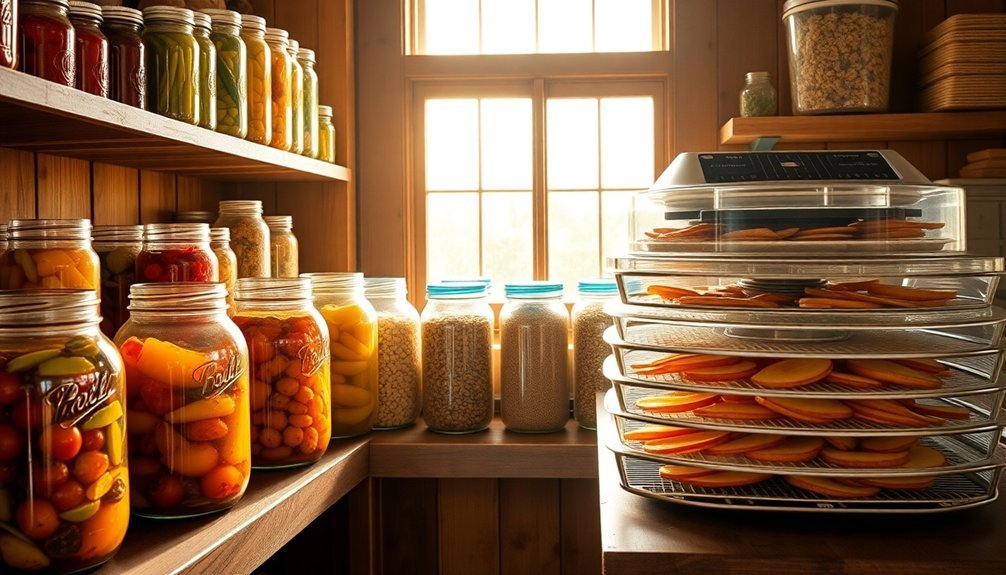
When storing food prepared using solar energy, proper storage practices are essential to maintain freshness and prevent spoilage.
You'll need to store dry foods in airtight containers at temperatures between 50°F and 70°F, keeping humidity below 60%. For refrigerated items, maintain temperatures under 40°F and organize separate areas for vegetables to prevent cross-contamination. Solar cookers can serve as storage for leftovers, making them a practical option for both cooking and food preservation.
Your frozen foods will stay safe indefinitely at 0°F, but you should label and date them to track quality.
Don't forget to handle specific vegetables differently – store root vegetables and squashes in cool, ventilated spaces between 50°F and 60°F, while keeping lettuce rinsed and drained in your refrigerator.
Remember to remove tops from carrots, radishes, and beets before refrigeration, and let tomatoes ripen at room temperature.
Cooling Your Solar Cooked Meals
After mastering proper food storage, your next priority is cooling your solar-cooked meals effectively.
You'll need to bring your food's temperature down to a safe range between 52-10°C quickly to prevent bacterial growth. Solar cooking generally produces meals at gentle temperatures around 120-160°C, making cooling more manageable than with traditional high-heat methods. Use insulated containers and place them in shaded areas to protect your meals from direct sunlight.
Keep these essential cooling strategies in mind:
- Place your hot dishes in shallow containers to speed up the cooling process
- Transfer food into clean, airtight containers once cooled to maintain freshness
- Use food thermometers to verify safe temperatures throughout the process
- Don't hesitate to use cooling packs or wet towels to accelerate cooling
Remember to store your cooled food in the refrigerator whenever possible, and avoid reheating meals multiple times to prevent foodborne illness risks.
Vacuum Sealing Sun-Prepared Dishes

You'll get the most from your solar-cooked meals by properly vacuum sealing them for future enjoyment.
Following basic temperature guidelines, let your sun-prepared dishes cool to room temperature before sealing them in appropriately sized vacuum bags.
Make sure to remove any debris from the bag's edges and double-seal when possible to maintain ideal freshness of your solar cuisine.
Maximizing Solar Meal Freshness
Preserving the delicious results of your solar cooking adventures requires an effective storage solution, and vacuum sealing stands out as the perfect method. When you're ready to store your sun-cooked meals, cut your vacuum bag 3 inches longer than needed and guarantee a proper seal by placing it evenly in the sealer.
- You'll love how the flavors and nutrients stay locked in, keeping your solar-cooked masterpieces as fresh as the day you made them.
- You can feel good about reducing food waste while saving precious freezer space.
- You'll appreciate the convenience of reheating your meals simply by placing the sealed bags in hot water.
- You'll be amazed at how your sun-cooked dishes maintain their quality for months, even years.
Remember to blanch any vegetables first and pat everything dry before sealing to guarantee the best results for your solar-prepared meals.
Preventing Post-Sun Meal Spoilage
Vacuum sealing sun-cooked meals takes food preservation to the next level. You'll extend your dishes' shelf life considerably by removing oxygen that causes spoilage, keeping red meat fresh for up to 6 weeks in a camping fridge and other foods fresh for years when frozen.
To guarantee safety, always use clean utensils and avoid touching food directly. Before sealing, blanch your vegetables and freeze any liquids to prevent gas buildup and suction issues.
Place paper towels around meats to absorb excess moisture and protect the bag's integrity.
When it's time to reheat, you can simply submerge the sealed bag in hot water or use your microwave. For ideal organization, store your sun-cooked meals in portion-sized bags, making them easy to stack and access when needed.
Freezing Solar Cooking Leftovers
When you're ready to freeze your solar-cooked leftovers, you'll need to select airtight, freezer-safe containers that prevent freezer burn and maintain food quality.
You must cool your sun-prepared dishes quickly before freezing, using methods like ice baths or spreading food in shallow containers to reduce the temperature below 50°F. Any food left in the danger zone temperatures between 50°F and 125°F for more than 3-4 hours must be discarded rather than frozen.
Make certain you're labeling each container with the contents and date to track storage time and guarantee food safety.
Proper Container Selection
To safely store your solar-cooked leftovers in the freezer, you'll need containers that can withstand extreme temperatures while protecting food quality. Glass jars and freezer-safe ceramic containers offer the safest, chemical-free options for long-term storage. While Pyrex containers work well, focus on using the glass portion rather than the plastic lids whenever possible.
- You'll appreciate glass jars' versatility and transparency, making it easy to identify contents.
- Your food stays pure and chemical-free, away from harmful BPA found in plastic.
- You're protecting both your health and the environment by choosing sustainable materials.
- You can trust these containers to maintain your food's flavor and nutritional value.
Remember to leave adequate headspace in your containers, as frozen food expands.
Label everything clearly, and don't overcrowd your freezer to prevent container damage.
Quick Cooling Methods
Proper cooling is essential when freezing your solar-cooked leftovers. You'll need to cool your food to below 50°F quickly to prevent harmful bacterial growth. Move your solar cooker to a shaded area and transfer the food to a cool box or insulated container.
Speed up the cooling process by using cold water or ice, but always monitor the food's temperature with a thermometer.
Don't let your cooked food stay in the danger zone (40°F-140°F) for more than 3-4 hours. If you can't cool it rapidly, keep it above 125°F until you can.
Once cooled, store your food in airtight containers before freezing.
When you're ready to eat, reheat thoroughly to 165°F. Remember, if food has stayed too long in the danger zone, you'll need to discard it, as reheating won't eliminate all toxins.
Dehydrating After Solar Cooking

After solar cooking your meals, dehydrating leftover food offers an excellent way to extend its shelf life while preserving nutrients.
You'll want to verify your food is at 120°F-160°F for ideal dehydration, whether you're using an electric dehydrator, oven, or DIY solar setup. Remember to arrange items in single layers and trim excess fat from meats to speed up the process.
- Feel confident knowing you're preserving essential vitamins and fiber through proper dehydration
- Experience peace of mind with thoroughly dried foods that won't spoil
- Save money by preventing food waste and creating long-lasting supplies
- Enjoy the satisfaction of using sustainable preservation methods
For best results, maintain good airflow during the drying process and store your dehydrated foods properly to maintain their quality.
Pre-treat your items by washing and cutting them uniformly to verify even drying throughout.
Container Selection for Storage
Once you've dehydrated your solar-cooked foods, selecting the right storage containers becomes your next key step.
You'll want containers that are airtight to prevent spoilage and freezer burn. Virgin HDPE containers offer an excellent choice, as they're durable, food-grade, and won't retain odors or flavors.
If you're planning to reheat foods directly in the container, opt for glass alternatives that can safely shift from freezer to oven.
While they're heavier and more expensive, glass containers won't stain or absorb odors. For purely storage purposes, HDPE containers provide the best value with their lightweight design and stackability.
Make sure your chosen containers have reliable seals, and if they include silicone components, check that they're limited to the sealing areas only.
Proper Temperature Control Methods
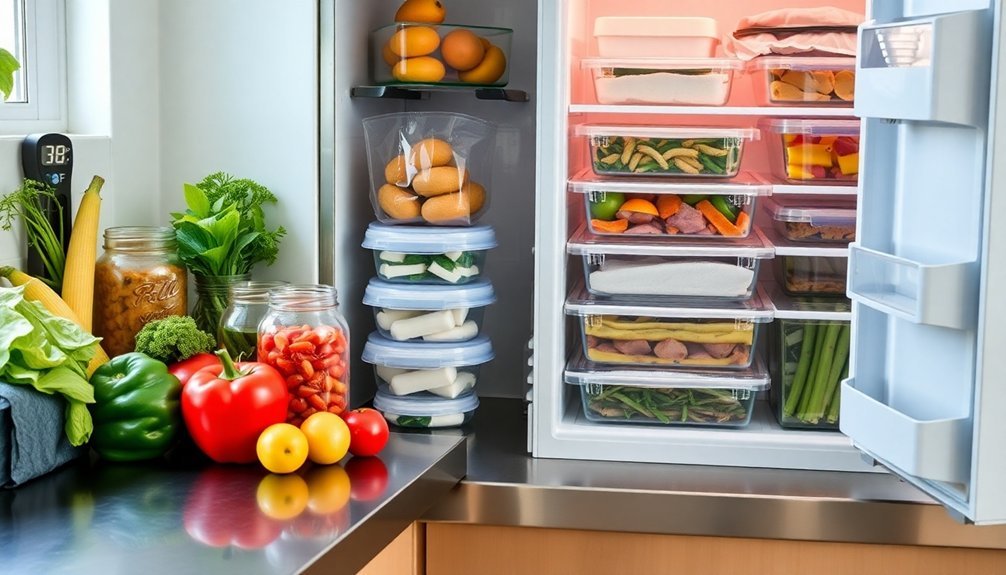
Temperature control stands at the heart of successful food preservation, whether you're using solar power or traditional methods.
After your sun-powered meal, you'll need to choose the right temperature approach based on your food type and preservation goals.
- Feel confident knowing your food's safe when you maintain refrigeration at 0-7.2°C for fresh items
- Experience peace of mind with frozen foods stored at -18°C to halt harmful microorganisms
- Enjoy the satisfaction of properly dried foods at 140°F, preventing unwanted cooking
- Take pride in achieving ideal solar drying results at temperatures above 85°F with humidity below 60%
You'll want to monitor temperature consistently throughout your chosen preservation method.
For dried foods, don't forget to store them below 70°F in your home's coolest area.
If you're using solar drying, remember that timing varies – fruits need 2-4 days, while vegetables require 3-5 days for best results.
Shelf Life of Solar Food
Your sun-dried foods can last anywhere from a few months to two years, depending on your storage method and the type of food you're preserving.
While dried fruits maintain their quality for 6-12 months in cool, dark spaces, dried vegetables typically need consumption within 4-6 months unless frozen.
You'll get the longest shelf life by combining proper temperature control with vacuum sealing and oxygen absorbers, which can extend storage times up to two years for most solar-dried foods.
Storage Duration By Method
Different storage methods for solar-dried foods offer varying shelf life spans, with proper techniques yielding remarkable longevity. When you're storing your solar-dried bounty, you'll find that vegetables can last an impressive 10+ years, while fruits typically maintain quality for up to five years.
- You'll feel proud knowing your stored harvest can feed your family for years to come.
- You'll gain peace of mind by reducing food waste and saving money.
- You'll experience satisfaction watching your collection of preserved foods grow.
- You'll be empowered knowing you're contributing to a sustainable future.
To maximize storage duration, keep your dried goods in containers with tight-fitting lids, and store them in a cool, dark place.
Don't forget to dust dried fruits with powdered sugar or spices to prevent sticking, and always label your containers for easy organization and monitoring.
Heat Impact On Preservation
While preserving food through solar methods offers sustainable benefits, understanding heat's impact on shelf life remains essential for successful long-term storage.
You'll need to monitor temperature carefully, as exposure to heat can greatly reduce how long your food stays fresh. For example, leaving milk at room temperature for just over three hours can cut its shelf life by one day.
To protect your solar-preserved foods, keep them out of the "danger zone" between 40°F and 140°F, where bacteria multiply rapidly.
If you're using thermal preservation methods, you'll notice some trade-offs – while heating kills harmful microorganisms, it can also affect vitamins, color, and taste.
Your best strategy is to store preserved foods in cool conditions whenever possible, as lower temperatures slow down both chemical reactions and bacterial growth.
Extending Your Solar Meals
Successfully preserving solar-dried foods requires understanding proper storage techniques and environmental conditions. When you store your solar-dried treats properly, you'll retain 80-85% of their nutritional value without using any artificial preservatives.
Keep your foods in airtight, moisture-proof containers and store them in cool, dry places to maximize their shelf life.
- Feel confident knowing you're reducing food waste while creating a sustainable food reserve
- Experience peace of mind with a natural preservation method that maintains authentic flavors
- Enjoy the satisfaction of having nutritious, chemical-free food available year-round
- Save money and energy while contributing to environmental conservation
Remember to check your stored items regularly for signs of moisture or spoilage.
Natural Preservation Techniques
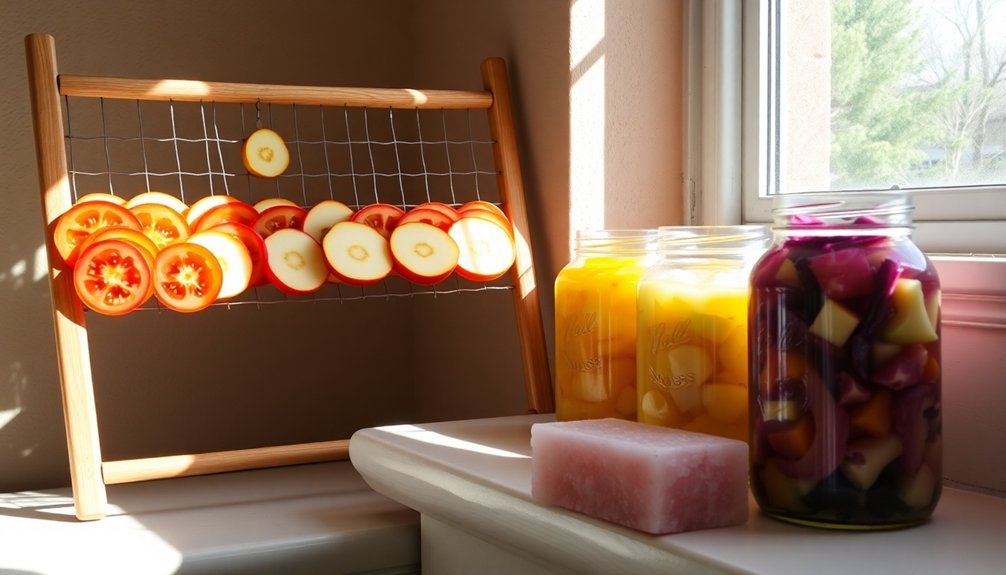
Natural food preservation techniques offer reliable ways to extend the shelf life of your solar-cooked meals without relying on modern refrigeration.
You can choose from several time-tested methods: canning your food in sterilized jars using either a water bath or pressure canning method, drying ingredients with solar power or a dehydrator, or fermenting foods to create beneficial preservatives.
You'll also find powerful natural preservatives in your pantry.
Salt and sugar work by drawing out moisture from foods, while garlic provides anti-bacterial protection.
For longer-term storage, consider adding rosemary extract to prevent oils from going rancid, or incorporate Kakadu plum to extend shelf life by up to three months.
Remember to always use clean equipment and follow proper guidelines to guarantee your preserved foods remain safe to eat.
Safe Reheating Practices
Properly reheating your solar-cooked meals is essential for both safety and taste.
You'll need to reheat food to 165°F quickly, using equipment like ovens or microwaves to minimize time in the danger zone between 41°F and 135°F.
Don't forget to preheat your equipment and use a food thermometer to verify temperatures.
When using your microwave, stir food periodically and let it stand covered for 2 minutes after heating.
Remember, you should only reheat food once.
- Your family's health depends on proper reheating temperatures
- You'll feel confident knowing your leftovers are safe to eat
- You're protecting your loved ones from harmful bacteria
- You're preserving the delicious flavors of your sun-cooked meal
If food isn't hot enough, adjust your reheating time and check the temperature again before serving.
Best Storage Equipment
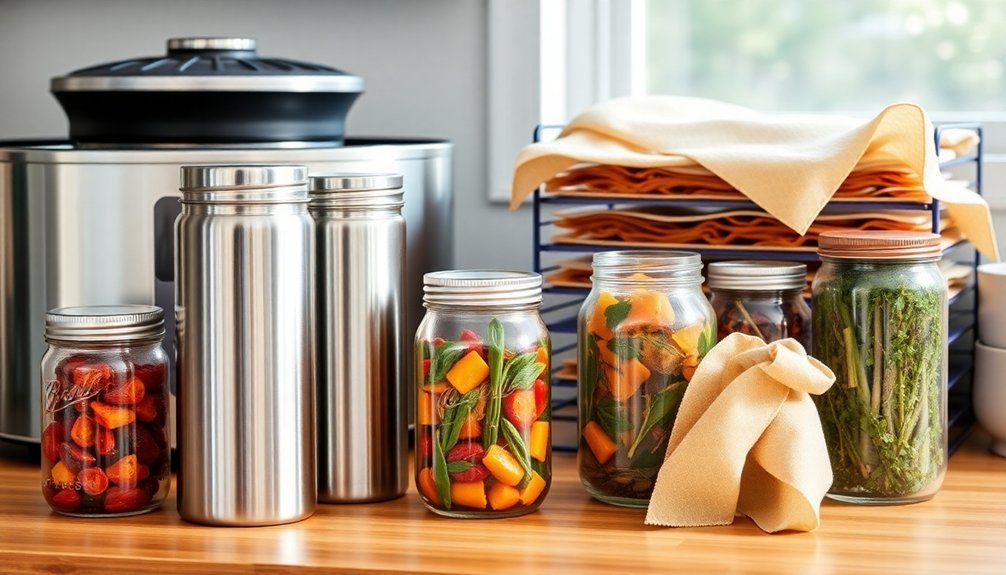
Selecting the right storage equipment makes all the difference in preserving your solar-cooked meals.
You'll want containers made from durable materials like polycarbonate or polypropylene, with brands like Rubbermaid and Cambro offering reliable options. Look for features that guarantee your food stays fresh, such as airtight seals and sturdy snap-on lids.
For maximum effectiveness, choose containers with silicone gaskets or vacuum-sealed bags to prevent air from compromising your food's quality.
If you're storing larger quantities, consider specialized bulk storage solutions that accommodate ingredients like rice, flour, or beans. Don't forget to use proper labels to track your inventory.
When selecting containers, verify they're both dishwasher and freezer-safe for convenience.
Preventing Food Spoilage
Once you've chosen the right storage containers, understanding food preservation methods will help protect your solar-cooked meals from spoilage.
You'll want to combine different techniques to maximize shelf life and maintain food safety.
- Keep your meals fresh by vacuum sealing them immediately after cooling – you'll love how this simple step locks in flavors.
- Transform your leftovers into tomorrow's delights by freezing them at 32°F or below.
- Experience the satisfaction of traditional preservation by trying your hand at pickling or smoking.
- Save money and reduce waste by mastering proper storage temperatures for different food types.
For your solar-cooked meals, focus on methods that don't require additional energy, like drying or cold storage.
When you're ready to store hot foods, let them cool completely first to prevent condensation that could lead to bacterial growth.
Frequently Asked Questions
Can Solar-Cooked Food Be Preserved Using Traditional Fermentation Methods Like Kimchi Making?
You'll face challenges fermenting solar-cooked food like kimchi since cooking kills essential bacteria needed for fermentation. If you want to try, you'll need to add starter cultures to replace the lost beneficial microorganisms.
How Does Altitude Affect the Preservation Time of Solar-Cooked Meals?
At higher altitudes, you'll need to increase preservation times since water boils at lower temperatures. You should add 1-2 minutes per 1,000 feet elevation and adjust pressure canning settings accordingly for safe storage.
Do Solar-Cooked Preserved Foods Retain More Nutrients Than Conventionally Cooked Ones?
You'll find solar-cooked preserved foods generally retain more nutrients like proteins, calcium, and iron than conventional methods. However, they'll have less vitamin C due to longer cooking times and lack of protective cooking oils.
Can I Mix Solar-Cooked and Traditionally Cooked Foods in the Same Preservation Batch?
Yes, you can mix solar-cooked and traditionally cooked foods in the same preservation batch. Just be mindful that textures and moisture levels might vary, so you'll need to adjust your preservation methods accordingly for best results.
Does Solar Cooking Affect the Effectiveness of Chemical Preservatives in Food?
You don't need to worry about solar cooking affecting your chemical preservatives. It won't impact their effectiveness since preservatives are typically added after cooking, and solar cooking's main preservation comes from heat and moisture control.
In Summary
You'll find that proper food storage after solar cooking is just as important as the cooking process itself. Store your sun-cooked meals promptly, use appropriate containers, and monitor storage temperatures carefully. Whether you're vacuum sealing, freezing, or dehydrating, following these preservation methods will keep your solar-prepared foods safe and delicious. Remember, you're not just saving energy by cooking with the sun – you're also preserving nature's bounty.
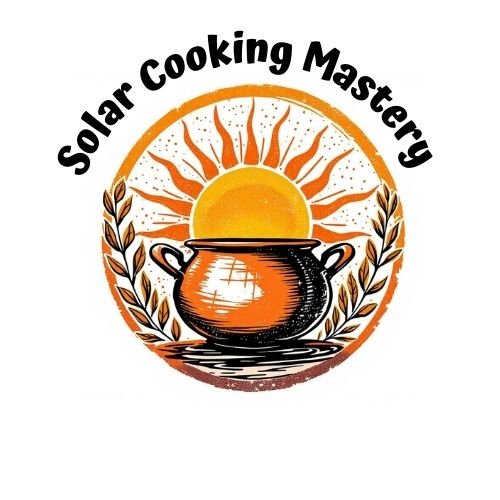




Leave a Reply